Introduction to Veterinary Orthopedic Surgery and Instruments
Orthopedic surgery is one of the most critical fields in veterinary care. Whether you’re treating a broken limb in a puppy, correcting hip dysplasia in a senior dog, or repairing a fractured wing in an exotic bird, having the right tools is essential for success.
Veterinary orthopedic surgical instruments are specially designed to meet the unique anatomical and biological needs of animals. Unlike human instruments, veterinary tools must accommodate varying sizes, bone densities, and tissue resilience.
Ready to upgrade your surgical instrument set?
Explore our Veterinary Orthopedic Instrument Collection today crafted for precision, designed for care.
Tip; Think of a Golden Retriever with a torn ACL (cranial cruciate ligament). Just like in humans, surgery is often the best treatment. Without the right surgical instruments, even a skilled vet can’t perform precise repairs, risking longer recovery or failed outcomes.
Basic Surgical Instruments Commonly Used in Veterinary Orthopedics
Orthopedic surgeries begin with foundational tools. These instruments are not exclusive to orthopedic cases but are essential for any surgical procedure.
1. Scalpel Handle with Blades (Multiple sizes)
What It Is: The scalpel is the primary instrument for making surgical incisions.
Usage: In orthopedic surgery, a No. 10 blade is commonly used for large skin incisions, while No. 15 is ideal for smaller or more precise cuts. A veterinary surgeon may use a No. 15 blade when exposing a small joint, like the carpus in a cat.
2. Metzenbaum Scissors
What It Is: These delicate scissors are designed for cutting soft tissue with precision.
Usage: When dissecting around delicate muscles or separating fascia during a fracture repair in a dog’s femur, Metzenbaum scissors ensure minimal trauma.
3. Mayo Scissors
What It Is: Heavier than Metzenbaums, these scissors are built for cutting thick tissues.
Usage: Commonly used to trim ligaments or cut through fascia in larger dogs during hip surgery.
4. Mayo-Hegar Needle Holder
What It Is: A sturdy needle holder without a cutting edge.
Usage: Ideal for orthopedic suturing, especially when closing deep muscular layers in a canine TPLO (Tibial Plateau Leveling Osteotomy) procedure.
5. Olsen-Hegar Needle Holder
What It Is: Combines needle holding and cutting capability.
Usage: Useful in fast-paced procedures where efficiency is key, such as in fracture repair of long bones in emergency cases.
6. Adson Tissue Forceps
What It Is: Fine-toothed forceps for handling delicate tissue.
Usage: Often used in small animal orthopedic surgery when suturing subcutaneous tissue or fascia.
7. Brown-Adson Forceps
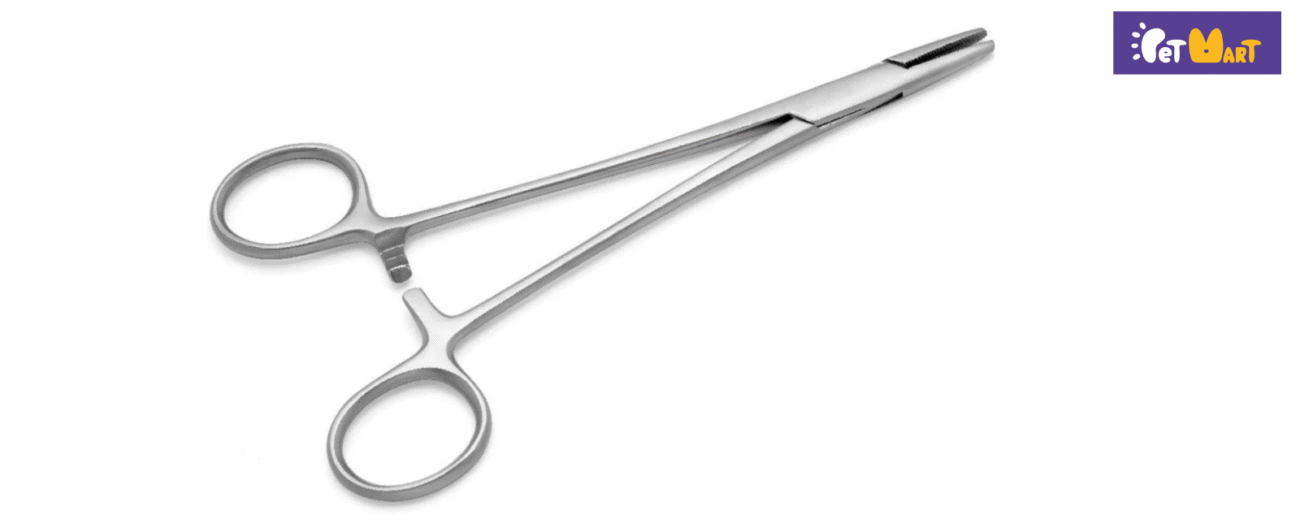
What It Is: Multi-toothed forceps offering a firm grip.
Usage: Preferred during bone exposure procedures as they offer greater control without tearing tissues.
8. Kelly Hemostats
What It Is: A versatile hemostatic clamp used to control bleeding.
Usage: During the dissection of muscular tissue in a limb fracture, Kelly forceps temporarily clamp off bleeding vessels.
9. Crile Hemostats
What It Is: Similar to Kelly but with serrations running full length.
Usage: Frequently used for clamping vessels and blunt dissection during implant site preparation.
10. Halsted Mosquito Forceps
What It Is: Small, fine forceps used in precise vascular control.
Usage: Ideal in feline orthopedic surgeries where vessels are smaller and space is limited.
11. Gelpi Self-Retaining Retractor
What It Is: A self-locking retractor with pointed tips.
Usage: Helps hold back deep muscle layers during complex hip or femoral surgeries, maintaining clear visibility.
12. Weitlaner Retractor
What It Is: A self-retaining retractor with blunt or sharp prongs.
Usage: Especially useful in exposing joints or bones in medium to large dogs during cruciate ligament repair.
13. Army-Navy Retractor
What It Is: A manual double-ended retractor.
Usage: Assists veterinary assistants in holding soft tissue aside during bone drilling or pin insertion.
14. Senn Retractor
What It Is: Small retractor used in superficial surgeries.
Usage: Common in feline fracture repairs and superficial orthopedic soft tissue elevation.
15. Langenbeck Retractor
What It Is: A single-blade manual retractor.
Usage: Helpful in exposing bone edges during osteotomy procedures in limb deformity correction.
16. Periosteal Elevator (e.g., Freer or Key Type)
What It Is: A thin-bladed instrument to separate periosteum from bone.
Usage: Essential for exposing long bones like the humerus or femur prior to internal fixation.
17. Bone Rongeurs
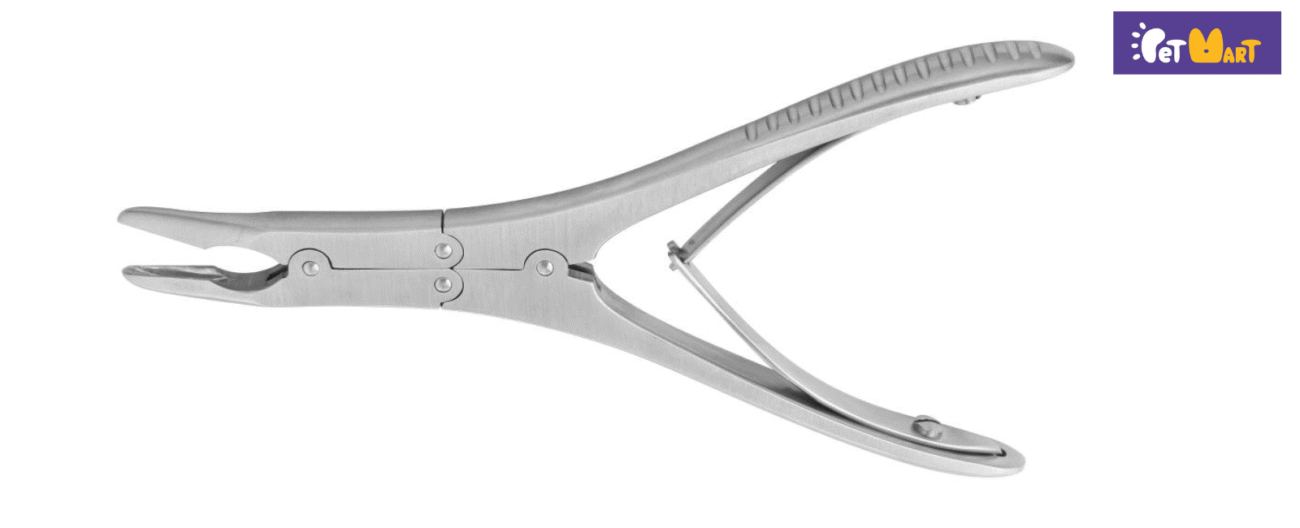
What It Is: Heavy-duty instruments designed to bite and remove small bone fragments.
Usage: Often used to clear out bone debris or smooth rough edges during orthopedic cleanup.
18. Wire Twister/Driver
What It Is: A specialized instrument used to secure and twist orthopedic wires.
Usage: Vital during cerclage wire application in fractured bone stabilization, especially in the mandible or long bones.
19. Surgical Mallet
What It Is: A small hammer used to assist instruments in bone work.
Usage: Helps drive osteotomes or chisels while performing bone reshaping or controlled fractures.
20. Bone-Holding Clamps
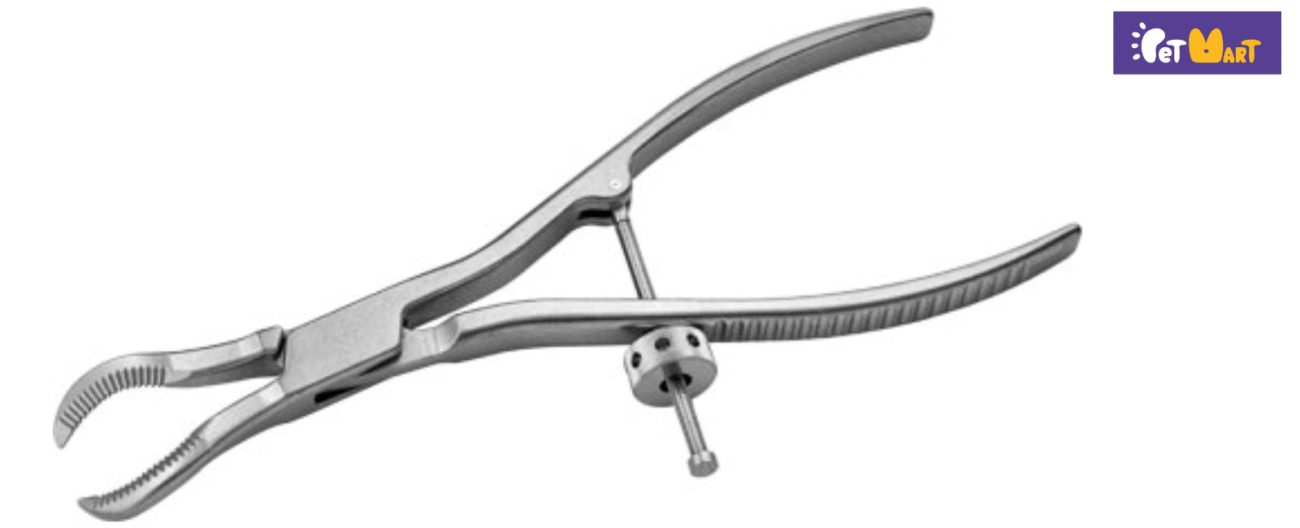
What It Is: Used to stabilize bone fragments during reduction and fixation.
Usage: Essential in maintaining proper alignment of fractured bone segments before plating or pinning.
These foundational tools are the unsung heroes of every veterinary orthopedic procedure. Whether you’re fixing a fractured tibia in a German Shepherd or performing a corrective osteotomy in a small-breed dog, choosing the right instrument—and using it correctly—ensures safer, more efficient surgeries and better outcomes for your patients.
Specialized Orthopedic Instruments and Their Functions
When basic instruments aren’t enough to handle the bone-deep work of veterinary orthopedics, it’s time to bring out the heavy hitters. These specialized tools are designed specifically for cutting, holding, shaping, or repairing bones and joints in animals—from tiny toy breeds to giant livestock.
Let’s break down the most commonly used specialized orthopedic instruments in veterinary surgeries, how they work, and where they shine in real-world scenarios.
1. Osteotomes
What It Is: A chisel-like instrument with a beveled edge used for cutting or reshaping bones.
Usage Example: During corrective osteotomy in a limb deformity, the surgeon may use an osteotome to make controlled bone cuts in the radius or ulna.
Why It Matters: It gives clean cuts with precision, especially in growth deformity corrections.
2. Gigli Wire Saw
What It Is: A flexible wire saw used for controlled bone cutting.
Usage Example: In pelvic or limb amputations where traditional saws are hard to maneuver, the Gigli wire can make curved or tight cuts without damaging surrounding tissue.
Why It Matters: Great for confined surgical spaces and for avoiding power tools in small patients.
3. Bone Cutting Forceps
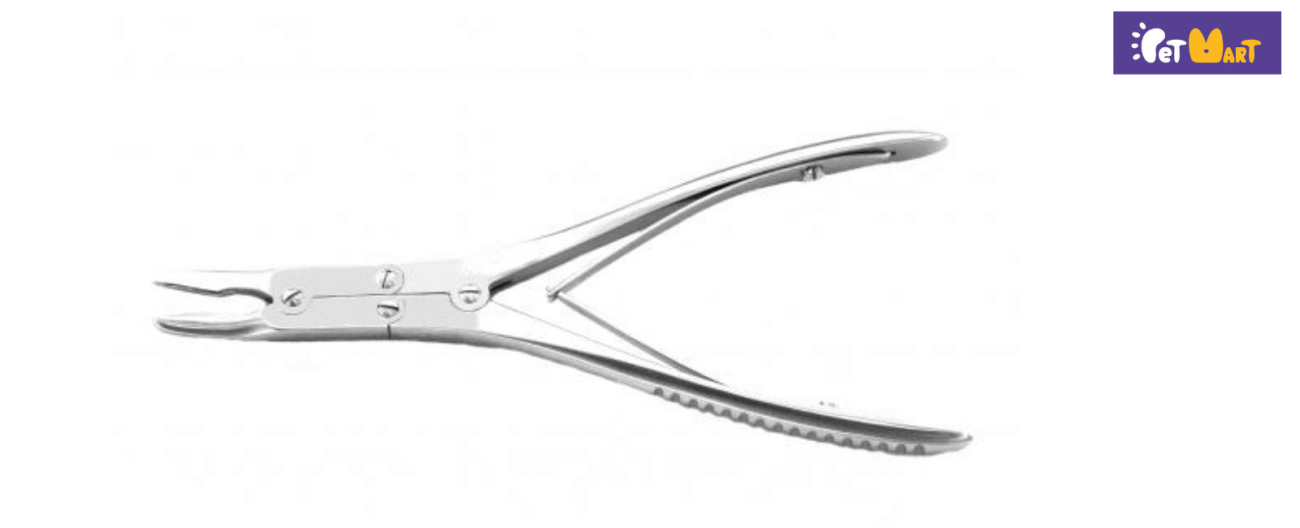
What It Is: Heavy-duty forceps designed to bite and slice through bone.
Usage Example: Used in laminectomies or removing bone overgrowth around joints, especially in older animals.
Why It Matters: They offer strong grip and cutting control without requiring electric tools.
4. Bone Rongeurs (Double Action or Single Action)
What It Is: Strong forceps used to nibble away small bone fragments.
Usage Example: In orthopedic clean-up or spinal surgeries, rongeurs remove fragments or smooth rough bone edges.
Why It Matters: Vital for reshaping and smoothing bones during fracture realignment.
5. Lambotte Osteotome Set
What It Is: A set of orthopedic chisels used in precision bone cutting.
Usage Example: Perfect for controlled cuts during wedge resections in angular limb deformities.
Why It Matters: Offers accuracy when removing or reshaping bone with minimal trauma.
6. Bone Curettes
What It Is: Spoon-shaped tools used to scrape or remove bone or cartilage.
Usage Example: Often used in bone cyst removal or to clean infected or necrotic bone in osteomyelitis cases.
Why It Matters: Essential for debriding and cleaning bone cavities without damaging healthy structures.
7. Raspatories and Rasps
What It Is: Instruments for scraping or smoothing bone surfaces.
Usage Example: Common in joint surgeries like femoral head ostectomy (FHO) to smooth bone ends.
Why It Matters: Prevents rough bone edges that could cause soft tissue irritation post-surgery.
8. Periosteal Elevators (e.g., Molt, Freer, Key Type)
What It Is: Designed to lift the periosteum (bone lining) during exposure.
Usage Example: In a TPLO procedure, the elevator helps reflect soft tissue cleanly to expose the tibial plateau.
Why It Matters: Minimizes trauma to surrounding tissues while accessing the bone.
9. Verbrugge Bone Holding Forceps

What It Is: Self-retaining clamps that lock onto bones during fracture alignment.
Usage Example: Keeps fractured femoral segments aligned while placing a bone plate.
Why It Matters: Ensures precision during internal fixation and reduces the need for additional hands.
10. Kern Bone Holding Forceps
What It Is: Heavy-duty gripping forceps with a strong, curved beak.
Usage Example: Used in large dog orthopedic repairs where firm bone grip is essential.
Why It Matters: Holds bone firmly without crushing it, especially in big-bone surgeries.
11. Pointed Reduction Forceps
What It Is: Instruments with pointed tips for manipulating and aligning bones.
Usage Example: Great for aligning fractures before pin or plate application.
Why It Matters: Ensures bone fragments are properly placed, avoiding malunions.
12. Drill Guides and Sleeves
What It Is: Guide tools that ensure accurate angle and depth while drilling.
Usage Example: Used during locking plate application to align screw holes perfectly.
Why It Matters: Reduces surgical error and guarantees precision in screw placement.
13. Bone Drills (Manual or Powered)
What It Is: Drills that create holes for pins, screws, or plates.
Usage Example: Drilling the femoral shaft in a dog for cortical screw insertion.
Why It Matters: A stable screw starts with a precise hole—these tools make it happen.
14. Pin Cutters
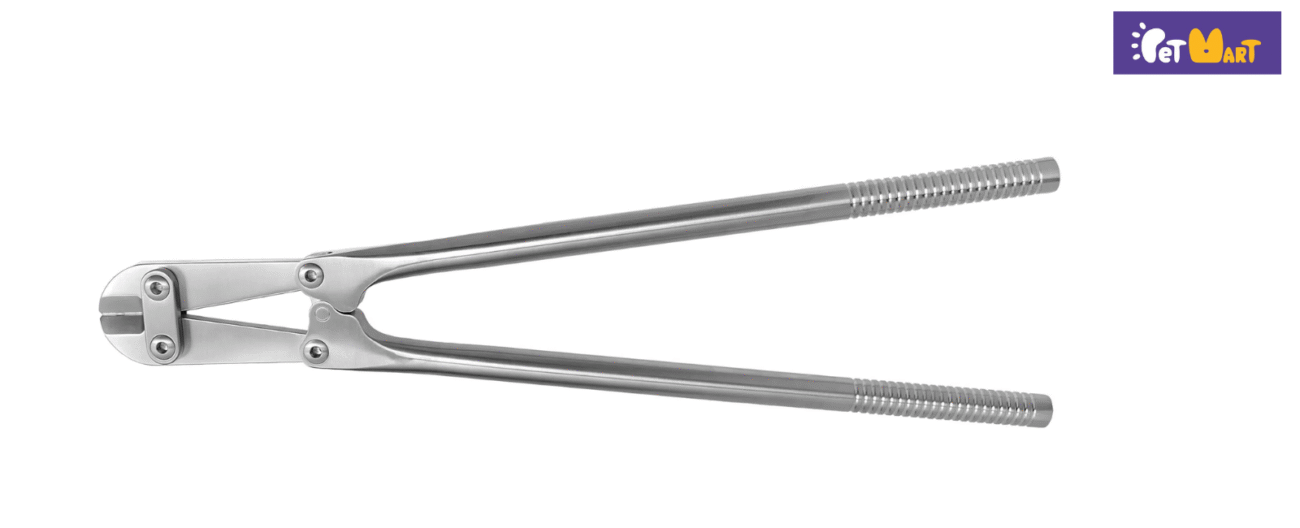
What It Is: Cut and trim orthopedic pins or wires to the correct length.
Usage Example: After external fixation, any excess Kirschner wire is trimmed with a pin cutter.
Why It Matters: Prevents protruding hardware that could injure the animal or handler.
15. Kirschner Wires (K-wires)
What It Is: Smooth pins used for internal fixation.
Usage Example: Used to stabilize small fractures in kittens or puppies.
Why It Matters: Simple, cost-effective, and minimally invasive.
16. Steinmann Pins
What It Is: Larger diameter orthopedic pins.
Usage Example: Useful for intramedullary fixation in large breed dogs’ long bone fractures.
Why It Matters: Stronger support in bigger bones needing stable alignment.
17. Wire Twisters and Drivers
What It Is: Used to twist cerclage wire tightly around bone.
Usage Example: During tibial fractures, wire twisters help maintain compression with cerclage wire.
Why It Matters: Secure wire = stable fixation = quicker healing.
18. Self-Retaining Retractors
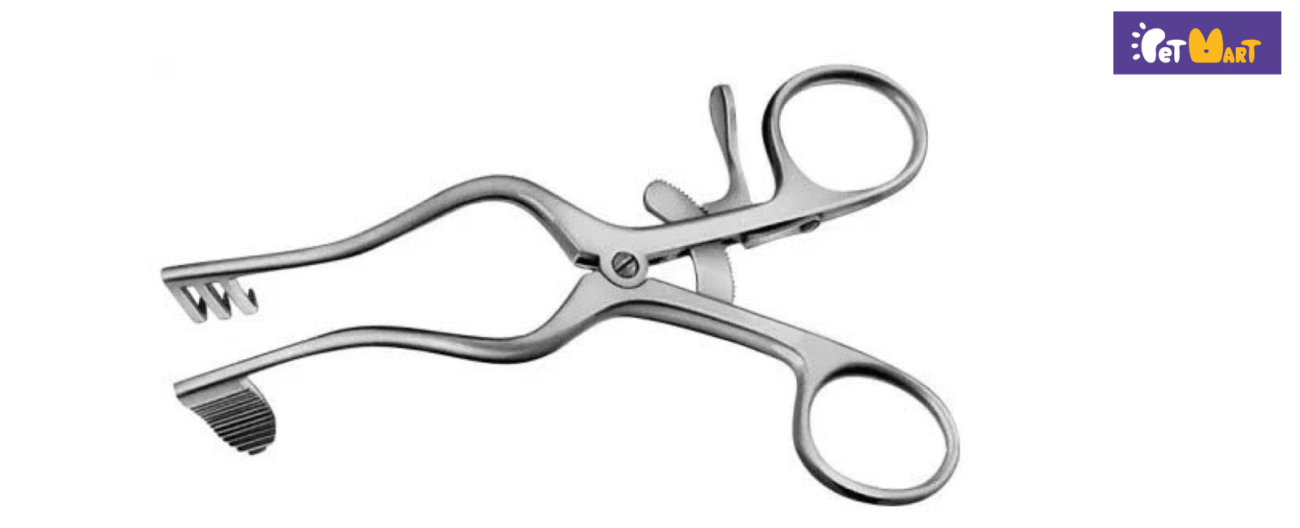
What It Is: Retractors that hold surgical fields open on their own.
Usage Example: Keeps deep tissue open during stifle joint surgeries.
Why It Matters: Frees up the vet’s hands while maintaining visibility.
19. Trephines
What It Is: Circular saws used to remove bone plugs.
Usage Example: Used in bone graft harvesting from the iliac crest.
Why It Matters: Clean core sampling while preserving graft integrity.
20. Cannulated Reamers
What It Is: Hollow drill bits that enlarge holes for implants.
Usage Example: Used in preparing the medullary canal for rod or screw placement.
Why It Matters: Ensures implants fit snugly without damaging bone.
Orthopedic Instrument Sets
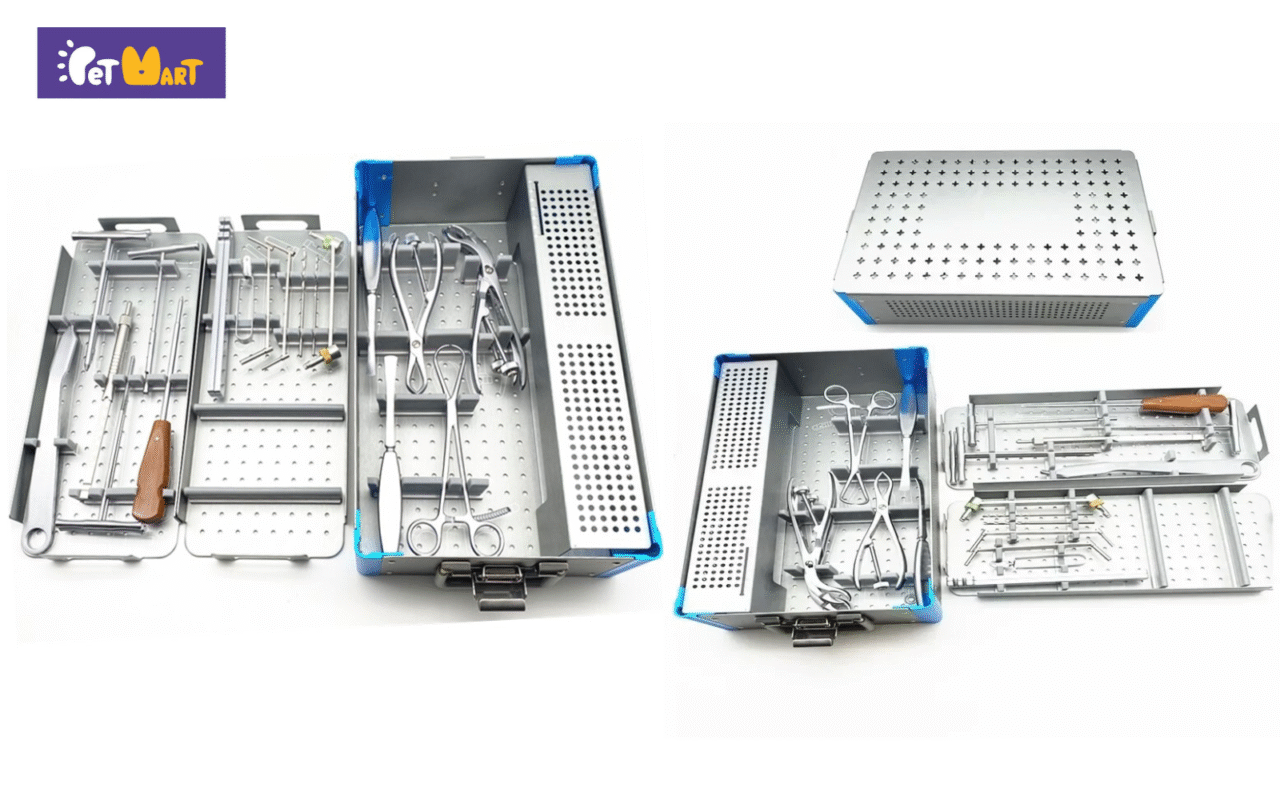
What’s Included?
A complete veterinary orthopedic instrument set is tailored for efficiency and quick access during surgery.
| Instrument Category | Common Inclusions |
|---|---|
| Cutting Tools | Bone saws, rongeurs |
| Fixation Tools | Drills, pins, wires |
| Retraction Tools | Gelpi, Hohmann, Senn |
| Tissue Handling Tools | Forceps, scissors |
| Suturing Tools | Needle holders |
For Small Animals: Instruments are smaller and lighter, ideal for cats, dogs, rabbits, etc.
For Large Animals: Heavy-duty tools made for cattle, horses, or goats, often with longer handles and more leverage.
Implant Systems in Veterinary Orthopedics
Orthopedic surgeries often require implants to ensure stability and healing.
Bone Plates
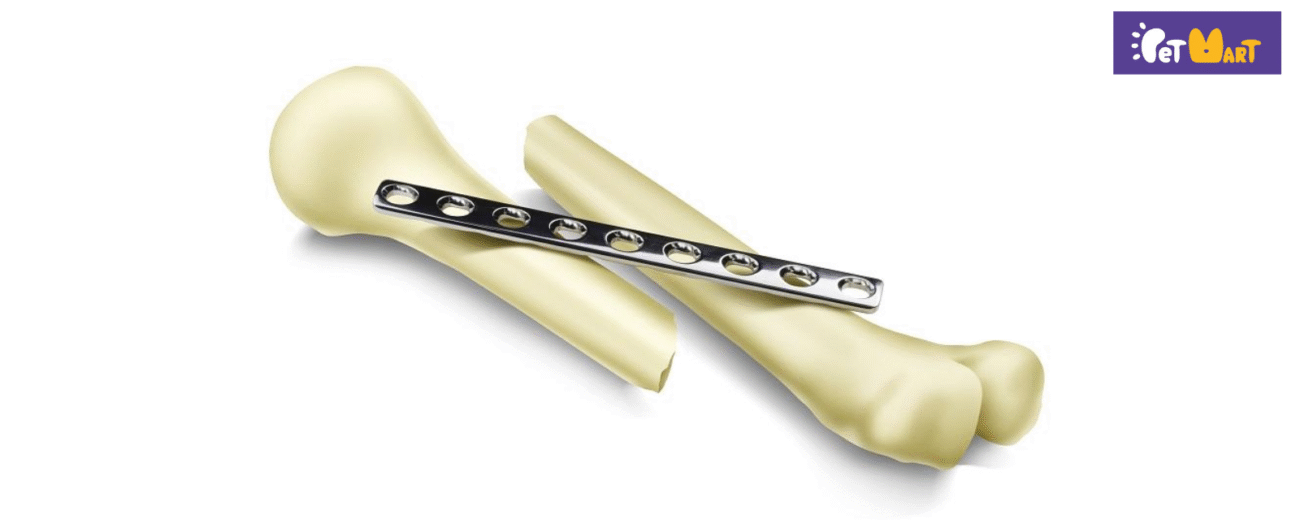
- Dynamic Compression Plates (DCP): Encourages natural bone compression for healing.
- Locking Compression Plates (LCP): Offers rigid fixation, especially useful in poor bone quality.
Screws
- Cortical Screws: Fine-threaded, used in dense bone.
- Cancellous Screws: Coarse-threaded, used in spongy bone.
Use in Practice
A Labrador with a tibial fracture may need a locking plate and 6 cortical screws for secure fixation. These are inserted using a surgical drill, aligned with the plate holes
Instrument Materials and Quality Considerations
The quality of instruments significantly affects performance and safety.
Material Choices
- German Stainless Steel: Industry gold standard for durability, sharpness, and corrosion resistance.
- Titanium: Lightweight, hypoallergenic, but costlier.
Risks of Poor-Quality Instruments
- Infections due to micro-corrosion
- Fractured tools during surgery
- Increased surgery time and post-op complications
Care, Maintenance, and Sterilization of Orthopedic Instruments
Proper maintenance ensures longevity and reliable performance.
Cleaning Protocols
- Pre-Cleaning: Rinse immediately post-surgery
- Ultrasonic Cleaning: Deep cleans hinges and joints
- Manual Scrubbing: For delicate tools
Sterilization Guidelines
- Autoclaving: Most instruments are autoclave-safe.
- Dry Heat: Used where moisture can cause damage.
Storage and Inspection
- Keep tools in instrument trays or sterilized pouches.
- Regularly inspect for rust, cracks, or misalignment.
Tips for Choosing the Right Veterinary Orthopedic Instruments
Selecting the right tools isn’t just about price—it’s about precision and results.
Factors to Consider:
- Animal Size: Use appropriately sized instruments.
- Procedure Type: Intramedullary pinning? Get wire drivers and pin cutters.
- Surgeon Comfort: Ergonomic handles reduce fatigue.
- Reputation of Supplier: Choose FDA/CE verified vendors.
Advances and Innovations in Veterinary Orthopedic Surgical Instruments
The field is evolving with new tools and tech.
Modern Advancements:
- Minimally Invasive Kits: Smaller incisions, faster recovery
- Arthroscopic Tools: For joint surgeries with minimal trauma
- 3D Printed Implants: Customized bone scaffolds and replacements
Example;
In arthroscopy, a small camera and micro tools allow vets to fix ligament tears without opening the entire joint.
Final Thoughts
The success of orthopedic surgeries depends heavily on using the right instruments. From precision cutting tools to advanced fixation devices, every piece plays a crucial role. As veterinary medicine continues to evolve, so do the tools that support it. Investing in quality instruments, maintaining them properly, and staying updated with advancements ensures better care for animal patients and greater confidence for veterinary professionals.
Final Takeaways:
- Choose quality over cost.
- Match instruments to the procedure and patient.
- Keep learning and upgrading your toolkit.

